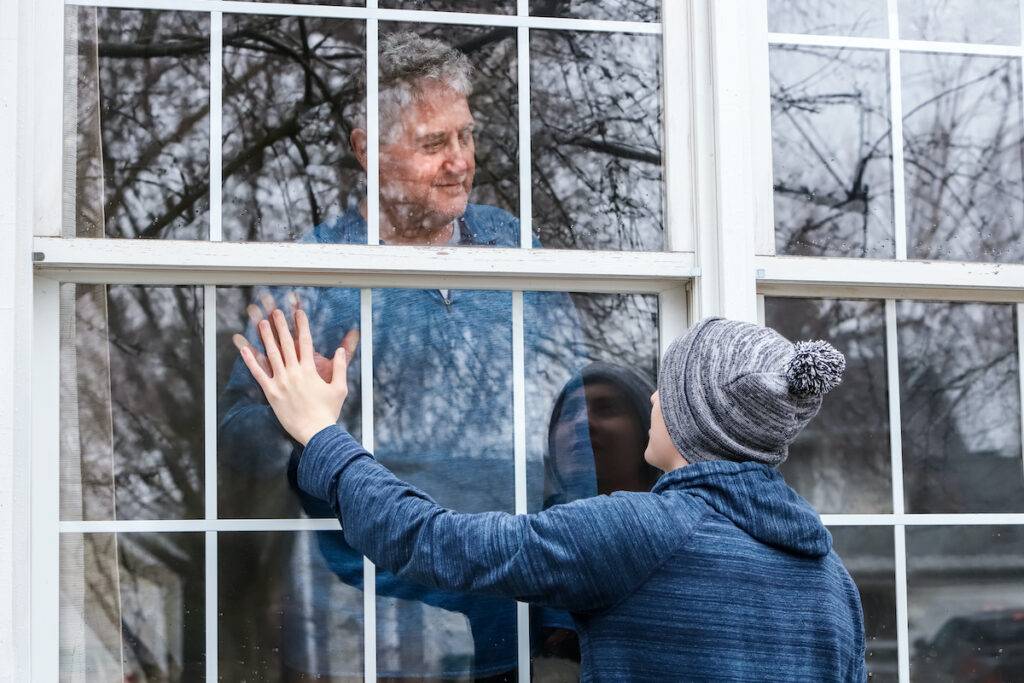
Care homes are hitting the headlines at the moment and COVID-19 has highlighted the vital role of the sector and the chronic neglect of residents and staff by politicians and the wider NHS. We expect a lot from our care homes in the UK. We want them to be great places for people to live in, and many are, but they are also where many frail older people with dementia and complex multi morbidity will spend their last months. Care home staff are often expected to manage these conditions with relatively little support from external healthcare services (Sampson et al, 2018).
Currently in the UK more than 420,000 people aged over 65 years live in care homes. There are two main types, with approximately 220,000 people living in “care home with nursing” (nursing homes) and 200,000 in “residential homes” which provide support with activities for daily living but have no registered nurses on site (Laing and Buisson 2017).
The King’s Fund and British Geriatrics Society have raised concerns about the quality of healthcare provision. There was a 63% increase in all-cause hospital admissions from nursing homes between 2011-2015 and the UK National Health Service (NHS) has made reducing “avoidable” hospital admissions from nursing homes a priority (Bardsley et al, 2013). Going into hospital can be upsetting for residents, their families and the staff who look after them. Hospital admission can have a range of detrimental impacts on frail older people, particularly those with dementia; their function in activities of daily living may decline and they are at higher risk of delirium, adverse events and prolonged stays (Mukadam & Sampson, 2010; Watkin et al, 2012).
Over the last few years there have been significant attempts, often at a local level, to improve healthcare provision. In this blog I’ve been asked to consider one approach (the Care Home Innovation Programme) to reduce the numbers of care home residents admitted to hospital (Giebel et al, 2020).

63% increase in all-cause hospital admissions from nursing homes was noticed between 2011-2015 and the NHS has made reducing “avoidable” hospital admissions from nursing homes a priority, while 420,000 people in the UK currently reside in a care home.
Methods
The paper (Giebel et al, 2020) describes an evaluation of a quality improvement programme and I’ll summarise using key points from the SQUIRE (Standards for Quality Improvement Reporting Excellence) guidance. The project was set in the South Sefton clinical commissioning group (CCG) in the north west coast area of England. The multi-component intervention, a Care Home Improvement Programme (CHIP), aimed to provide enhanced healthcare support to care home residents including:
- Proactive review and support from a Community Matron allocated to each care home
- Access 24 hours per day to an advanced nurse practitioner
- Coordinated multidisciplinary team approach with palliative care, GPs, community geriatricians
- Bi-monthly multi-disciplinary meetings
- Care home staff training
- Access to protocols for common clinical presentations such as falls and shortness of breath
- Support with monthly newsletters and quarterly Quality Improvement Collaborative meetings between care homes.
The project launched in April 2015 and ran until June 2018. Outcome data were collected from April 2014 until April 2019 at system-level:
- Ambulance service: total number of emergency 999 calls from care homes, and conveyances to hospital were collected
- Key performance indicator data from contractual data supplied by participating organisations.
Data were analysed using time series analyses with run charts.
Results
From the beginning of the programme 32 care homes participated (17 residential and 15 nursing, including a total of 1,314 residents) with over half (56%) rated “good” by the Care Quality Commission (CQC). The Care Home Improvement Programme (CHIP) was associated with a 15% reduction in emergency calls (from a mean of 143 calls to 999 per month prior to the programme) and a 19% reduction in conveyances to hospital. The run charts indicate that seasonal effects, which increase numbers of ambulance calls from care homes over the winter months, were smoothed. Ambulance 999 calls increased again after the programme finished.

The programme smoothed seasonal variations in acute hospital admissions, resulting in a 15% reduction in emergency calls and a 19% reduction in conveyances to hospital.
Conclusions
Giebel et al. (2020) concluded:
This four-year evaluation of the CHIP implementation has shown that CHIP was effective in reducing potentially avoidable hospital admissions in care home residents.

The CHIP programme is important in supporting care home residents with health issues in the comfort of their care home.
Strengths and limitations
All limitations I’m discussing are caveated by the fact that the authors may have had access to limited data and may not have been involved in setting up or running the programme. Although the authors state there were no major changes, we don’t know what was happening in the local health and social care economy over this time. The care home market can be unstable (e.g. did any care homes close?). Changes in the “denominator” could lead to fewer care home residents and thus fewer calls. Conversely, if care home beds increased, this could be masking beneficial effects of the intervention.
The type of care home is key. Similar UK studies show these interventions have most impact in residential homes where there is no onsite nursing (Lloyd T. et al, 2019). Therefore presenting run charts according to care home type may have shown the CHIP programme was even more effective in residential homes.
Demonstrating the impact of service changes is challenging; can we confirm the outcomes were directly due to the intervention and what was the “active ingredient”? Whilst the run charts show an improvement we can’t tell which strands of the intervention were most beneficial? The programme was based on a frequently used quality improvement technique known as PDSA (Plan, Do, Study, Act) cycles; it would be really interesting to know about adaptations made through each cycle. A “deeper dive” evaluation using mixed methods including interviews with staff and residents would help unpick what worked. Ensuring interventions are underpinned by theory and co-designed with end-users can ensure delivery on the ground.
We need to consider adverse effects. We assume reducing conveyances is a “good thing”, however some residents may have benefitted from hospital admission. Preventing an admission shifts the burden of care and costs from the NHS back into already pressured care homes. More individual-level data on resident wellbeing or mortality during the project may have given context to these findings.
The paper has many strengths including a good discussion of the ethics of using routinely collected data. The elements of the intervention are outlined clearly and run charts support the headline findings. Conducting randomised controlled trials for this type of intervention is extremely challenging and projects like this are vital in highlighting impact in “real world” settings.

Quality improvement programmes may be useful for testing the “real world” impact of interventions.
Implications for practice
There is evidence, mainly from the USA, that multicomponent interventions may reduce care home resident hospital admissions. Whilst the USA INTERACT programme, which informed the CHIP programme, initially demonstrated reductions in hospitalisations, a subsequent larger randomised controlled trial in 85 USA nursing homes showed no effect (Ouslander et al, 2011). There is a growing UK literature on improving health in care homes. A multi-disciplinary team using care planning as a mechanism to seek external specialist support, and GP involvement supported by integrated external services are fundamental (Gordon et al, 2018, Chadborn et al, 2019). A programme in east London (2013-2017), which provided nursing home residents with increased GP access and continuity of primary care reduced emergency hospital admission and A&E attendances (Sherlaw-Johnson et al, 2018). NHS England’s local area demonstration projects “Vanguards” implemented similar initiatives and provide further promising evidence (Lloyd et al, 2019).
Care homes now provide the majority of long term healthcare to older people in the UK. They do this well with relatively little support from external health care services. In the Netherlands care homes employ specialist elderly care physicians and their residents are rarely admitted to hospital, but, care homes in the UK are not “mini-hospitals” and some people rightly object to them being called “the hospices of the future”; they are people’s homes. We could argue that we should make acute hospitals better places for people with dementia.
The language we use is loaded. Admissions may not be “avoidable”, “inappropriate” or “unnecessary” if a resident, who has equal right to access acute hospital care as any of us, cannot obtain necessary healthcare where they live. A singular focus on reducing acute hospital admissions is potentially dangerous and does not take a holistic view of resident health. This can lead to care homes and their residents being “blamed” for hospital admissions and “taking up” hospital beds. We have to be careful; rhetoric can easily drift into more dangerous territory that “care home residents should not be admitted into hospital”. Public awareness of care homes has risen during the COVID-19 crisis. It will be interesting to see how the inevitable post-pandemic enquiries view the provision of health care to care home residents and whether more initiatives, such as the CHIP programme, are supported in the future.

During the COVID-19 pandemic there have been great concerns regarding equitable access to healthcare for care home residents.
Statement of interests
Liz Sampson was a co-investigator on the BHiRCH-NH (Better Health in Residents of Care Homes with Nursing) programme and led a pilot trial of a complex intervention to improve health outcomes in care home residents.
Links
Primary paper
Giebel C, Harvey D, Akpan A, Chamberlain P. (2020) Reducing hospital admissions in older care home residents: a 4-year evaluation of the care home innovation Programme (CHIP). BMC Health Serv Res. 2020;20(1):94. doi:10.1186/s12913-020-4945-9
Other references
Bardsley M, Blunt I, Davies S, Dixon J. Is secondary preventive care improving? Observational study of 10-year trends in emergency admissions for conditions amenable to ambulatory care. BMJ Open. 2013;3(1):e002007.
Chadborn NH, Goodman C, Zubair M, et al. Role of comprehensive geriatric assessment in healthcare of older people in UK care homes: realist review. BMJ Open. 2019;9(4):e026921.
Gordon AL, Goodman C, Davies SL, et al. Optimal healthcare delivery to care homes in the UK: a realist evaluation of what supports effective working to improve healthcare outcomes. Age Ageing. 2018;47(4):595‐603
Laing and Buisson (2017). Care of Older People UK Market Report.
Lloyd T, Conti S, Santos F, Steventon A. Effect on secondary care of providing enhanced support to residential and nursing home residents: a subgroup analysis of a retrospective matched cohort study. BMJ Qual Saf. 2019;28(7):534‐546.
Mukadam N, Sampson EL. A systematic review of the prevalence, associations and outcomes of dementia in older general hospital inpatients. Int Psychogeriatr. 2011;23(3):344‐355
Ouslander JG, Lamb G, Tappen R, et al. Interventions to reduce hospitalizations from nursing homes: evaluation of the INTERACT II collaborative quality improvement project. J Am Geriatr Soc. 2011;59(4):745‐753.
Sampson EL, Candy B, Davis S, et al. Living and dying with advanced dementia: A prospective cohort study of symptoms, service use and care at the end of life. Palliat Med. 2018;32(3):668‐681.
Sherlaw-Johnson, C., H. Crump, N. Curry, C. Paddison and R. Meaker (2018). Transforming health care in nursing homes: An evaluation of a dedicated primary care service in outer east London. London.
SQUIRE (Standards for Quality Improvement Reporting Excellence) guidance
Watkin L, Blanchard MR, Tookman A, Sampson EL. Prospective cohort study of adverse events in older people admitted to the acute general hospital: risk factors and the impact of dementia. Int J Geriatr Psychiatry. 2012;27(1):76‐82.
Photo credits
- Photo by eberhard grossgasteiger on Unsplash
- Photo by Eduard Militaru on Unsplash
